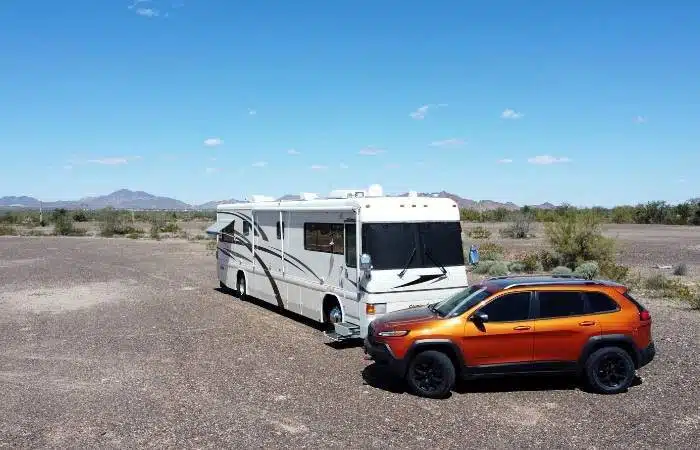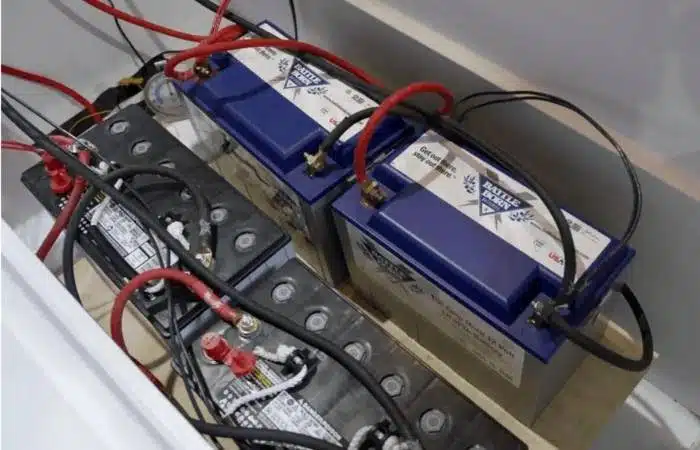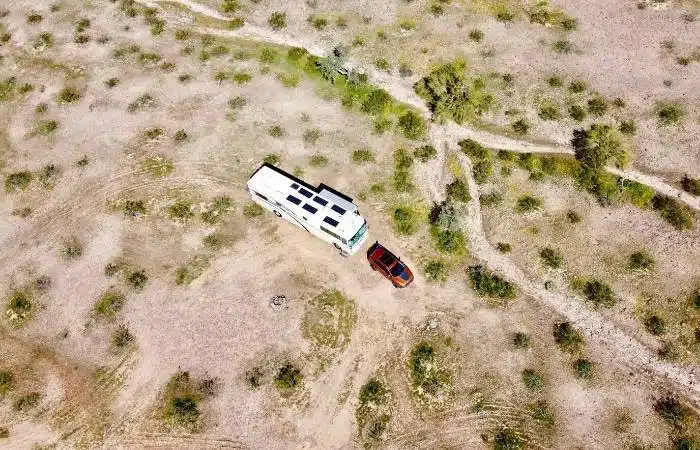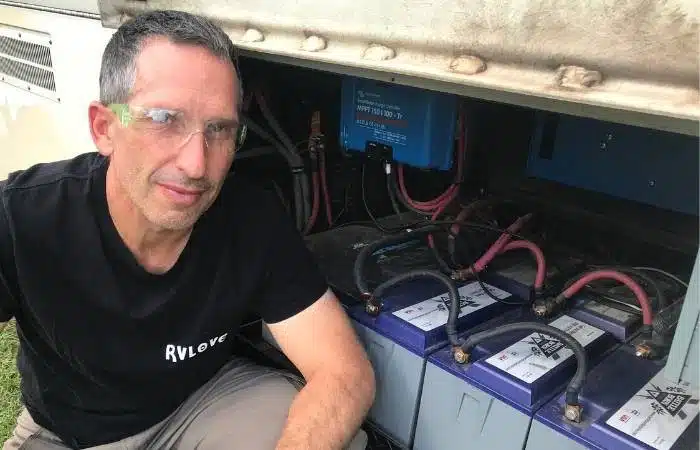This post may contain affiliate links.

With winter just around the corner, one of the most common concerns of RVers relates to their batteries. The big question is: which batteries work best in cold temperatures – lead acid (AGM) or lithium?
This can be a complex topic. With the latest release of some interesting new data testing on battery performance, we put together this article to simplify the key highlights for you.

RVs and Battery Power
One of the primary ways an RV is able to provide the convenience, comfort and enjoyment of electrical power while out camping is via the batteries. Traditionally, most RVs come equipped with either regular lead acid batteries or AGM batteries (also lead acid). But over the last few years, lithium batteries have become incredibly popular as a superior power supply.
If you’ve done any research at all on lithium-ion batteries, you would have undoubtedly discovered a limitation. Most lithium batteries generally will not accept a charge in temperatures below freezing. For example, the Battle Born Batteries we installed in our motorhome in 2018 have internal protections that will not allow charging if the temperature drops below 25 degrees Fahrenheit (approx. minus 4 Celsius). Further, they will not resume the ability to charge until the battery temperature exceeds 32 degrees (Zero degrees Celsius).
With this limitation in mind, some consumers have understandably – but incorrectly – come to the conclusion that lead acid batteries perform better in cold temperatures. In this study, released in a detailed white paper by Battle Born Batteries, LiFePO4 lithium batteries dramatically outperformed a similarly sized bank of lead acid AGM batteries.
The experiment – and subsequent white paper report – were produced to answer two of the most common questions Battle Born Batteries reported being asked about lithium battery performance, being:
- Do lithium batteries still work in cold temperatures?
- Can I charge my lithium batteries in colder climates?
Click here for more detail in the white paper report and/or watch the video below.
Key Takeouts from this Battery Experiment
We know this topic can be quite technical and confusing. So we have simplified some of the highlights we gained from the lithium vs lead acid study, and explain how it impacts you.
- When subjected to a 30amp draw (less than 400watts) at a room temperature of roughly 70 degrees Fahrenheit (21C), the lead acid batteries were only able to deliver 63 of their claimed 210 amp hours of power. Comparatively, the 200 amp hours Battle Born Lithium batteries delivered OVER 200 amp hours of power.
- As the temperatures got lower, the differences between lead acid and lithium became more and more pronounced, with lithium losing very little in delivered power. The lead acid battery delivered only 32 amp hours at the lowest temperatures tested.
- When drawing a larger amount of power (80amps) the results were even more dramatic. The lead acid battery was basically useless. The 210amp hour battery bank supplied less than ONE amp hour of power. By comparison, the lithium-ion battery continued to deliver 154 amp hours of power, even with temperatures of around 15 degrees Fahrenheit (minus 9.4 Celsius).

The battery experiment: lithium (Battle Born) vs lead acid (AGMs). Credit: Battle Born Batteries
What does that mean for you?
The idea that lead acid batteries are still worthwhile at cold temps was blown out of the water by this study. With so little available power from the lead acids, you would use it up very quickly and it will be difficult to replenish the power since lead acids are so slow to charge, especially when it is cold. Lead acids cannot be charged when super cold either, because of the resistance.
This nullifies the claimed benefit of lead acid over lithium batteries at cold temps.
Even more evidence that lithium is the king of batteries for RV, Marine, or off-grid home systems, even in cold weather. The fact that lithium can still deliver so much power at cold temperatures means that it can use some of that energy to power an external (or internal) heat supply. This, in turn, allows them to stay warm enough to accept power.
In a nutshell, all of this means that you can stay off grid longer, and in more comfort, with lithium batteries.

Benefits of Lithium vs Lead Acid Batteries
If you have researched lithium batteries, you would already be familiar with the more widely known benefits, including:
- dramatically lower weight
- the ability to use virtually all of the available power
- faster charging rates and
- dramatically longer life spans.
All of these existing benefits were already showing the lithium-ion as superior value, despite their higher initial cost, for those who do extensive RVing unplugged from power. This study clearly demonstrated that lithium also outperforms lead acids, in the one area previously hypothesized as a shortcoming.
We have had lithium batteries (600ah) in our RVs for about 4.5 years now, and they have been an amazing upgrade to our RV lifestyle. With less battery concern, and increased ability to camp off grid. When we were full time RVers, we tended to chase moderate temperatures most of the year.
But of course, there were still times when we find ourselves in colder weather, and need to pay extra attention to our batteries. Even more so now as part time RVers.

How we keep our batteries warm (safe) in cold temps
Fortunately, in our motorhome, we have a dedicated battery bay, which we’ve been able to keep at a moderate temperature, even in cold weather. Here how we do that:
- We are able to send some of the heat from our furnace into the insulated basement bay where the batteries are stored.
- There is also residual heat transferring through the floor of the living space, and heat generated from the inverter.
- When we are faced with sub-freezing temperatures (we have experienced lows in the teens Fahrenheit (minus 4 degrees Celsius) we put an additional heat source in the battery bay to keep the temperatures warmer. We normally use a 100 watt incandescent bulb in a shop light fixture hanging in the battery bay. This simple light keeps the bay, and batteries, substantially warmer. Don’t use an LED or fluorescent bulb. You need a lightbulb that actually produces some heat.
- We are also able to keep track of the temperature (and humidity) of our batteries using a SensorPush Wireless Thermometer/Hydrometer. We installed in our battery basement bay (and inside the RV). This allows us to wirelessly monitor the temperature and humidity of each area via the app on our smartphones, when in and around the RV.
- When we’re away from the RV, we set up the SensorPush WiFi Gateway, which connects to our router. This allows us to remotely monitor the temperature and humidity via the SensorPush app, no matter where we are. We also set up alerts on the SensorPush to notify us if/when the battery bay hit the minimum or maximum temperatures (or humidity) we have set on the device.
If we planned on spending significantly more time in cooler environments, we would consider investing in specially designed heating products, like the ones offered by Battle Born. If you are buying new lithium batteries, we suggest getting them with inbuilt heat sources, like the next generation batteries from Battle Born.
See our RV lithium battery and power system
If you caught our Ultimate RV Makeover Series, you would have learned all about our RV power and off-grid system in episode 5. We used it to power our entire off-grid RV renovation. In the article and video, I go into detail, explaining the benefits of lithium batteries, and why we decided to install them in our motorhome. I also talk about all the elements of our off-grid system, how it works, and what we’ve been able to do with it.
You can see the specific components of our Power System and Lithium Batteries here.
Discount Coupon Code: RVLOVE
Battle Born Batteries offers RVLOVE readers discounts when using coupon code RVLOVE at checkout. The coupon offers $50 off per battery. And also 25% off of merchandise like clothing. Coupons cannot be used in addition to sale pricing or other coupons.
Sign up for our email newsletter with the latest RV park reviews, news and updates.
GOT COMMENTS OR QUESTIONS?
We would love to hear from you. Drop us a note in the comments section below.
More Content Related to our Off-Grid RV Makeover
Want to check out more on our Ultimate RV Makeover Series? Hover over each image to see the title and episode name.

12 Lessons Learned from Our RV Renovation

Getting Our RV Ready To Travel After our RV Makeover

What Did It Cost? and RV Renovation Questions

Episode 8 The Final Reveal | Ultimate RV Makeover

Episode 7: Finishing Touches | Ultimate RV Makeover

Episode 6: We’re Nearly There! Ultimate RV Makeover

Episode 5: Powering Our Off-Grid RV Renovation | Ultimate RV Makeover

Episode 4: Re-Building Our RV | Ultimate RV Makeover

Episode 3: Tearing Our RV Apart! | Ultimate RV Makeover

Episode 2: What Are We Going To Do? Ultimate RV Makeover

Episode 1: Let’s Do This! Ultimate RV Makeover Series


6 thoughts on “Lithium Vs Lead Acid Batteries in Cold Temps”
I have a cabin in northern Minnesota where the temperature usually reaches -40F usually once a year and can reach -50F or even -60F in very extreme cases. I’m usually not there, so the cabin will get cold during these times.
Will Li batteries survive this or would I have to heat them? There’s just solar there and I’d have to use the batteries to heat themselves. There’s little light there in the winter so I’m not sure if the solar energy could keep up with heating the batteries for a week’s worth of -40F.
Hi Jason,
Wow! That is a very extreme environment. My feeling is that the lithium would survive better than lead acid, but not sure if much of anything would sustain those conditions. I am not expert enough to advice on such an extreme environment, so would recommend you reach out to Battleborn directly on that special use case. Here is there phone number if you didn’t have it already. (855) 292-2831
Thanks
Hi, guys! With our traditional battery bay it needs to be open to the air (under the steps) which obviously makes the bay difficult to keep warm. Can you (and did you) seal off your battery bay in CC when you upgraded to lithium? We’re like you (chasing moderate temperatures) but this would allow some residual heat from the living area to keep the batteries warmer.
Hi Dave,
Yes, we did seal off our battery bay in CC when we switched to Lithium. Not fully Air tight because we still had an AGM starter battery in that bay. But we closed off about 90% of the previous openings. If like in your gas motorhome battery storage area under the steps, the only batteries in the area are going to be Lithium, I would definitely feel comfortable completely sealing off the area. Many folks with Lithium even choose to keep them inside their RV. But.. then the challenge is changing the wiring and the storage. If switching to AGM, you would still need to ventilate some, but not as much as you do with the traditional lead acids. I must say, we absolutely loved our Lithium batteries for so many reasons. Folks who spend virtually all their time plugged into power won’t benefit much, but if you do much time unplugged at all, and plan on keeping the RV for a while, lithium has some great benefits. And… back to sealing up. We were able to keep our battery bay quite warm (in the 40s and even 50s) during weather in the teens and twenties by having the bay mostly sealed up, and just using the residual heat transferring down from the floor, and a simple shop light light bulb in the bay. Much better for battery health. Especially clear after reading the results of this recent study we talked about above. Save travels. -M
Great article on lithium vs. lead batteries. I have a 36 foot motorhome with an enclosed basement. The basement is heated with the LP space heater and works well to keep items stored there as well as our water systems and lithium batteries as long as the motorhome space heater is running. A few years ago, I ran 50 feet of pex tubing from a hot water pipe all around the basement and then to the fresh water tank. I installed a water solenoid switch to that energized by a thermostat in the basement. Our hot water is heated by electric, LP gas and the truck engine. So when we are on the road, heating from the truck heater, in a camp ground heating from shore power or in a remote area and heating from LP gas, we are confident the basement never runs below a set 38 degrees. Keep up the informative work your are doing. Thanks, Don, Honey and Zoey (the dog)
That’s a great solution Don! Thanks for your comment and sharing your solution! Stay warm out there!